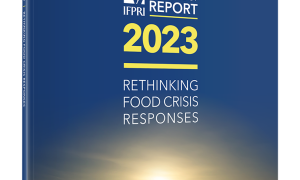Food systems and diets underpin many critical challenges to public health and environmental sustainability, including malnutrition, noncommunicable diseases, and climate change, but sustainable healthy diets have the unique potential to reshape th
Search
Building food security and resilience through intraregional trade in Latin America and the Caribbean
Intraregional agrifood trade in Latin America and the Caribbean (LAC) offers untapped opportunities for expansion.
Policymakers in Nigeria and other countries in Africa south of the Sahara (SSA) are relying on agriculture to generate employment for the growing youth population.
Agricultural credit is an important instrument for improving farm productivity, the welfare of farm households, and their resilience to weather-related shocks.
Globally, poor-quality diets are the leading cause of all forms of malnutrition, and the simultaneous occurrence of both under- and overconsumption within the same populations and even within the same households is increasingly common.
لقد واجه العالم الكثير من الازمات خلال عام 2022.
Egypt’s Takaful Cash Transfer Program: Impacts and recommendations from the second round evaluation
Egypt’s national cash transfer program, Takaful, and its sister program Karama covered 17 million poor beneficiaries as of 2022, about 16 percent of the Egyptian population.
En 2022, el mundo se enfrentó a múltiples crisis.
En 2022, le monde a subi des crises multiples.
2022年,世界面临多重危机。旷日持久的2019冠状病毒病疫情(COVID-19)、重大自然灾害、内乱和政治动荡以及气候变化日益严重的影响对食物系统的破坏仍在继续,而与此同时,俄乌战争和通货膨胀加剧了全球粮食和化肥危机。危机数量不断增加,多种危机的叠加影响日益加剧,饥饿人口和流离失所者数量不断攀升,促使人们呼吁重新思考粮食危机应对措施,从而为变革创造了一个真正的机会。
In 2022, the world faced multiple crises.
Agrifood value chains in the world’s low- and middle-income countries (LMICs) have expanded rapidly over the past decade, supplying an increasing volume and diversity of food products.
Recent global crises have led to diverse impacts across the world’s low- and middle-income regions, reflecting local conditions and differing policy responses.
Over the past two decades, social protection programs have become a mainstream policy tool to address chronic poverty and food insecurity in low- and middle-income countries (LMICs).
Global and national agrifood systems are vulnerable to a variety of shocks that have caused major disruptions to food production, markets, and livelihoods over the past two decades, and have set back efforts to reduce poverty, food insecurity, and
In human, economic, and environmental terms, the total cost of disaster and crisis response is extremely high, and the disastrous combination of the food price crises coming on the heels of the COVID-19 pandemic and natural calamities is straining
In 2022, the world faced multiple crises.
Now is the time to rethink how we address food crises. Better prediction, preparation, and resilience building can make future crises less common and less devastating, and improved responses can contribute to greater food security, better nutrition, and sustainable livelihoods
Gender inequality exists everywhere, but it is particularly stark in fragile and conflict-affected settings (FCAS).
Migration is a recurrent, complex, and multidimensional phenomenon driven by a broad set of factors.

